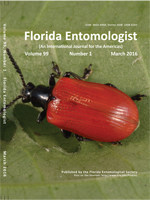In Sep 2013, nopal growers in Teotihuacan, Mexico, reported resinous secretions emerging from the base of the spines of mature cladodes. Cladodes with symptoms were collected, and the weevil species Cylindrocopturus biradiatus Champion and Cylindrocopturus ganglbaueri Heller (Coleoptera: Curculionidae) emerged. This work confirms the presence of both species, and it provides illustrations and descriptions for their diagnosis.
Some of the plants that belong to the genus Opuntia (Caryophyllales: Cactaceae) are highly valued vegetables in Mexican culture. The fruits (prickly pears) and the so-called “nopalitos” (young cladodes) are mainly used for human consumption, but also are used for livestock feed and as raw material for various industrial products (Sáenz et al. 2006). Nopal exploitation is done under 3 systems, namely, wild plantations, family gardens, and commercial plantations (Flores-Valdez 2001). This plant sometimes is affected by several insect pests that hinder production, making it necessary to have a correct identification of each of them to make handling decisions.
In Sep 2013, nopal growers of San Sebastian Xololapa, Teotihuacan Municipality, state of Mexico, Mexico, reported a strong presence of resinous secretions emerging from the base of the spines of mature cladodes. This study initially was conducted to identify the cause of this symptomatology. Twenty cladodes were collected and transported to the Agricultural Entomology laboratory of the Colegio de Postgraduados, campus Montecillo and confined in plastic containers covered with organdy gauze to await the emergence of the insects that caused the damage.
Adults started emerging on 2 Jan 2014. They were collected and preserved in 70% ethyl alcohol for later identification. Extraction of genitalia from the males was done through tissue maceration in KOH (10%). The results obtained from the taxonomic study were that 2 spine weevils coexisted in these Opuntia plants. Twenty-one adults of Cylindrocopturus biradiatus Champion and 16 of Cylindrocopturus ganglbaueri Heller (Coleoptera: Curculionidae) emerged from the collected cladodes. Distinctive characteristics can be seen to differentiate both species with the naked eye (Fig. 1). Cylindrocopturus biradiatus is smaller, with a mean length of 3.32 mm, it has frontal and lateral areas of the pronotum with orange color and light brown lines running parallel on the inner margin of the elytra with small perpendicular lines of the same color forming crosses that do not reach the outer margin of the elytra. Cylindrocopturus ganglbaueri is larger with a total mean length of 4.82 mm, with predominantly dark coloring and a black transverse dorsomedial line on its elytra.
Dampf (1929) reported on the presence of the nopal spine weevil, C. biradiatus. Later publications continued to mention the same species affecting nopal in several regions in Mexico, occasionally as an important pest for the crop (Flores-Valdez 2001; Sáenz et al. 2006; Vargas-Mendoza et al. 2008; Angeles-Nuñez et al. 2014). We detected that most reports are based only on symptomatology of the cladodes, and it was taken for granted that it was only due to C. biradiatus without confirming the taxonomy of the species. For example, Badii & Flores (2001) mentioned the incidence of C. biradiatus and described it as follows: “It is 4–4.5 mm long and has a dark dorsal mark in the form of a cross.” At least to our perception, this corresponds to the description of C. ganglbaueri.
On the other hand, Muñiz (1976) and Salas-Araiza et al. (2001) mentioned both species of spine borers; however, the reports show little information about these weevils. In this note, the aedeagus of each is shown and compared for the first time (Fig. 1). Both species show smooth margins with a round, slightly inclined tip, with greater sclerotization in C. biradiatus than C. ganglbaueri.






